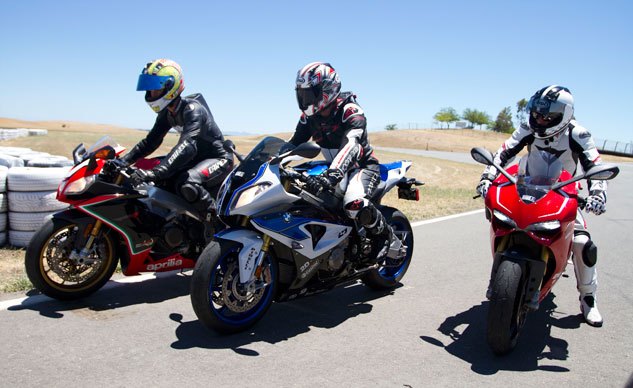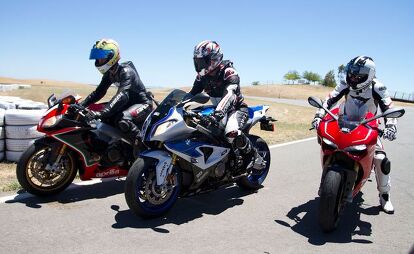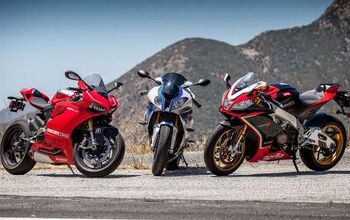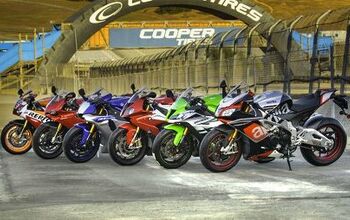2013 Exotic Superbike Shootout: Track – Video

By now, we’ll assume you’ve thoroughly read, digested and formed your own conclusions about the street portion of our Exotic Superbike Shootout featuring the Aprilia RSV4 Factory APRC ABS SBK SE, BMW HP4 and Ducati 1199 Panigale R. If not, click on the link to get yourself caught up. Simply put, these street-legal superbikes are apex predators, residing at the top of the most exotic, cutting-edge and downright fastest sportbikes on Earth.
Considering sportbikes are typically ridden on the street the majority of their lives, our street evaluations definitely serve a purpose. But you’d be foolish to believe these bikes weren’t designed for racetrack excellence.
It’s no secret that contemporary sportbikes are little more than racebikes with lights and it’s for this reason we took this trio to Thunderhill Raceway Park in Northern California. A MO favorite, this is one of a few tracks in the state capable of putting high-class literbikes through their paces. Here, we can actually row through the gears and twist the throttles to the stops thanks to its wide, flowing layout.
We joined our friends at Keigwins, one of the premier trackday providers in Northern California. We love riding with Lance and Linda Keigwin because their days always seem to run so smoothly. “A high level of professionalism is evident at every Keigwins event,” our Chief Editor Kevin Duke says. “You can tell the company has learned how to iron out all the usual trackday wrinkles through its years of experience.”
PREVIOUSLY: 2013 Exotic Superbike Shootout: Street – Video
Keigwins operates trackdays at Laguna Seca, Thunderhill, Sonoma Raceway, Buttonwillow and Miller Motorsports Park in Utah. Riders of all skill levels are welcome, and the staff goes out of their way to assist wherever they can.
Putting Power To The Ground
We begin at a natural starting point: engines. Take the BMW inline-Four, Aprilia V-Four and the V-Twin Ducati, and you’ve got three distinct ways to make massive amounts of power and deliver it in entirely different fashions.
You’re waking up a beast when twisting the throttle on the Ducati 1199 Panigale R. The Superquadro engine roars to life and spools quickly thanks to its titanium con-rods. Bump from the bottom end feels stronger than the standard Panigale, but it still requires high revs to get the most out of it – attributes not normally associated with a V-Twin.
MORE PANIGALE: 2013 Ducati 1199 Panigale R Review
“It pulled pretty well down low, although not as hard as an 1198, and then started building steam into what I thought was the top end,” writes guest tester and former soap opera star, Sean Matic. “I realized later that I was nowhere near redline and the bike had waaaay more top end than I first realized.”
Once you wrap your brain around revving the piss out of the V-Twin, the Duc’s “superior grunt allows it to pull the RSV4 on the front straight,” writes Duke. He also notes “mildly lumpy” throttle response from a closed throttle.
Riding the Panigale R is a visceral experience. The bark of the engine is loud even with earplugs in, and the connection between your right hand, the throttle butterflies and your butt is unlike anything else. It begs to be ridden hard, and rewards the rider when achieved.
Except in our case, when, near the end of our day at Thunderhill, the Superquadro engine in our Panigale R test mule decided to give up the ghost as Matic was exiting Turn 2. “I got on the gas as usual, but the power dropped and dropped and eventually died. Warning lights on the dash were flashing, so I pulled the clutch in and rolled off track.” A technical issue with a flagship superbike isn’t a problem to be taken lightly, so Ducati has sent our motor to Italy for a full investigation.
Meanwhile, the Aprilia V-Four, an engine we’ve become very fond of over the years, impressed us once again with its familiarity. Its distinctive sound and linear power delivery makes it one of our favorite engines among the MO staff, despite being down on top-end power compared to the others in this trio.
“Man, V-4’s are an awesome configuration!” says RSV4 first-timer, Matic, who also remarked about how instantly comfortable he felt on the bike, which allowed him to focus on learning the track during his first time at Thunderhill.
Meanwhile, with plenty of laps around T-Hill and lots of seat time on the Aprilia, Duke commented, “While it doesn’t have the top-end lunge of the others, [the RSV4’s] 160 galloping horses feel anything but slow, even around a fast track like Thunderhill.”
I agree with the prior assessments, but there were a few moments on track, mainly exiting slower-speed corners, where I noticed the Ape’s fuel conservation tricks mentioned in the street test hampering performance. The retarding of power below 6k rpm, no matter the riding mode, was downright annoying. But to put a silver lining on the situation, at least it gave an excuse to pin the throttle sooner at every opportunity!
All three testers were impressed with the Aprilia’s transmission, and it handily scored highest of the three bikes in the respective category on the MO scorecard, which we use to measure both objective and subjective traits to decide a winner. The Aprilia quickshifter was the smoothest of the bunch and never missed a beat, whether at full or partial throttle. Likewise, downshifts were equally buttery, though the non-adjustable clutch lever on our particular bike was set too far out for our liking.
The other two engines have their merits, but no matter how you slice it, the HP4 engine is the headliner of this test. It takes your breath away with incredible acceleration, leaving Sean no other words but, “soooooooo faaaaast!” in his notebook. Meanwhile, Duke estimates, “There’s probably less than 100K people on earth who have ever felt wheel-driven acceleration like this.”
Not only did our BMW pump out more than 170 horses to the rear wheel, but it did so with crisp, clean fueling, making it incredibly easy to control whether we were leaving pit lane or bombing down the front straight. With its sheer speed and remarkable usability, it’s no wonder the HP4 engine earned a perfect 100% from all three testers on the scorecard.
Made To Cut Quick Laps
A motto from one of the popular tire manufacturers once said “Power is nothing without control.” Never was this more evident than in the ’80s in the days of early superbikes. Back then, flimsy steel frames constantly twisted and flexed under the relatively big power tuners were making in the day.
It has taken decades for chassis technology to cope with the demands of their engines, but these three represent the pinnacle of production chassis development. In fact, the radical Ducati Panigale R doesn’t even have a traditional frame. It instead uses its engine as the main stressed member. Remove it and the rest of the bike will just be a pile of parts on the floor.
This technology was first tested in MotoGP with disastrous results, and the Alstare Ducati World Superbike team isn’t faring much better this year, even with former world champ Carlos Checa at the controls.
In our far-less-capable hands, all three testers were very impressed with how light and narrow the 1199 R felt underneath us. The frameless design puts the Ducati at 418 pounds with a full tank of fuel – only a single pound heavier than a Yamaha YZF-R6! “It feels remarkably slim and highly agile,” says Kevin.
The flyweight superbike surprised us with its extremely easy turn-in, with Sean noticing the ability to tighten or relax his line depending on pressure applied with his outside leg. But not all of us meshed well with the Panigale’s chassis. Personally, I judged its front-end feel as vague at the limit, especially compared to the nearly-telepathic front-end communication of the 1198 before it, so I had the least amount of confidence on the Ducati.
“Trying to set quick lap times gets exhausting on the hyperactive and occasionally frightening Duc,” Duke notes but adds, “When not being caned, the Panigale is a much less intense experience and feels almost easy to ride.”
We enjoyed the Panigale’s electronic suspension with the ability to adjust rebound and compression damping at the push of a button. However, we weren’t unable to find an optimum rear preload setting (which still requires a tool) before our engine expired.
Meanwhile, the Ape and Beemer, both with traditional twin-spar frames and bigger weight penalties (466 and 444 pounds, respectively) than the Duc were only marginally slower to turn, with the hefty RSV4 hiding its weight especially well thanks to its light forged wheels. Once leaned over, both returned fantastic feedback, with the Aprilia just edging the HP4 for outright handling honors, thanks largely to its superb mass-centralized feel.
To its credit, the HP4 wasn’t too far behind. “I thought the HP4 steered quicker than the Aprilia,” observes Duke. “Its forged wheels give it a turn-in advantage over the Ape, something the S1000, with its heavier cast wheels, could never claim.”
MORE HP4: Read our 2013 BMW HP4 Review
Matic mostly agrees, noting the BMW offers “very good cornering and front feedback but not quite to the level of the Ape for me. It didn’t roll on its axis or connect flip-flop sections quite so effortlessly.”
It’s odd to think of the Aprilia’s analog Ohlins suspension as being the least advanced here, but it is when compared to the electronic bits on the Ducati and BMW. Still, “while technologically a step or two behind the systems on its rivals, the Aprilia’s suspension performed admirably at Thunderhill,” says Kevin.
Meanwhile, BMW’s Dynamic Damping Control is the big talking point, whether on the street or the track. DDC is most impressive on bumpy public roads rather than smooth racetracks, but its ability to instantly adjust to the conditions “is almost like having a pro tuner in your pit, almost always providing an evolving setup suitable for each section of track,” notes Duke. “Its only noticeable flaw, as noted from our street testing, was the occasional shortage of rear rebound damping, evidenced at Thunderhill exiting the Cyclone section.”
Having never ridden a system like the BMW’s before, Sean commented, “Early in the day I was expecting the bike to be all over the place in the corners, but once banged over it was firm and taut.”
All three bikes offer an intimidating array of electronic aids, filled with an alphabet soup of acronyms to describe a few similar technologies: traction control, quickshifters, anti-lock brakes, ride modes and, in the case of BMW and Ducati, electronic suspension. The Aprilia’s TC is a great design, with the handlebar-mounted paddles able to adjust levels on the fly, but its electronics suite isn’t as impressive as those on the other two bikes. Ride modes are a nice touch, but at T-Hill “Track” was the only one we were concerned with.
In contrast, the Ducati and especially the BMW ride modes didn’t bore us. With the exception of Rain mode, every dry-weather ride mode proved more exciting as it inched closer to Race (Ducati) or Slick (BMW) modes, where the full potential of each bike could be unleashed. All three testers were impressed with the BMW’s Slick mode as, even with a shagged rear tire, we hardly noticed TC kick in.
In Race and Slick modes the Ducati and BMW trusts the rider to make the decisions, only stepping in when absolutely necessary. But this trust also works both ways: since I didn’t see the TC light illuminate even with a worn tire, it gave me confidence to pin the throttle sooner and harder the next turn.
From a user-interface perspective, Ducati’s full-color, TFT display is tops, with Sean noting, “The iPhone-like dashboard and tiered shift lights on the perimeter of the dash were awesome!”
Ducati worked exclusively with Brembo when designing the M50 brake calipers used on the Panigale, and all that effort paid off, as the 1199 R narrowly won the braking category of our scorecard. The light and compact brakes provide enormous power, with great feel all the way to the apex of the corner.
That said, Brembos adorn the Aprilia and BMW as well, with each delivering outstanding braking performance we’re accustomed to from the Italian brand. ABS is equipped on all three bikes and features a track setting with very high tolerances. How high? Enough for me to miss a brake marker down the back straight on the Aprilia, lift the rear wheel, and still not feel any ABS intervention.
Which Would We Pick
Picking a winner out of these three isn’t easy, and honestly, our garages would lovingly welcome any one of them were they to suddenly appear. In the Grin Factor category of the scorecard, which is simply a measure of how big a smile each bike puts on our faces, all three testers picked different machines.
The Aprilia, for its part, is a proven winner in our hearts for its exceptional performance time after time. We love the way it handles, adore its exhaust note and admire its compact package each time we throw a leg over it. Best of all, its $19,999 price tag beats the BMW by five large, and the Ducati by a whopping $10k!
“For my pace I’d probably stick with the Ape and let my higher confidence and comfort levels make up for the horsepower deficit,” says Sean, recognizing that the other two may be better for a more race-oriented rider.
“The RSV4, especially in its high-end Factory form, remains one of the most satisfying sportbikes in the world,” Kevin says. “The extra money demanded by the other bikes in this test is, given any sort of logic, not worth it.”
However, when deciding between exotica like this, price isn’t often a major concern. And in that regard Duke continues, “But if you want the best street-legal superbike, the bar has been raised.”
With a final score of 91.3%, the Aprilia RSV4 Factory APRC WSBK SE finishes in third place.
Kevin’s Grin Factor winner, the Ducati 1199 Panigale R, carries the heritage and reputation of all the superbikes before it. Indeed, it’s a technological step forward compared to Ducatis of yore. Park the Panigale anywhere and it’s sure to get looks from anyone who passes by.
On track, we loved the roaring exhaust note, its supreme agility and monster brakes, but we were never able to feel totally comfortable pushing the Ducati at the limits. Especially not on a consistent basis. The push-button suspension is a great feature, but it has its limitations. Top level racers we’ve spoken to have ditched the electric shock for a more traditional unit, for example. Still, with more time to experiment, we’re sure we could have found a suitable setup.
Despite its $30,000 price tag, Duke professes a soft spot for the 1199 R. “Okay, so it costs at least $5K more than its rivals – titanium conrods ain’t cheap – but I can’t imagine anyone who lusts after Ducati’s superbike wouldn’t fall in love with the Panigale R. It is stunning, both in appearance and performance, and it’s among a short list of the most thrilling motorcycles ever made.”
But even the wonderfulness of the 1199 Panigale R fell short in this magical sportbike trio. With a final score of 93.7%, it earns the runner-up spot.
Which leaves the BMW. It scored a 94.9% on our scorecard based on its incredible performance for a price $5000 less than the Ducati. We’ve waxed poetic about the engine and its usability, but for one simple reason: it’s that good.
Exotic Superbike Shootout Scorecard
| Motorcycle | Kevin | Sean | Troy | Total |
|---|---|---|---|---|
| Aprilia RSV4 Factory APRC ABS SBK SE | 90.6% | 93.1% | 91.9% | 91.3% |
| BMW HP4 | 97.3% | 94.8% | 95.4% | 94.9% |
| Ducati 1199 Panigale R | 93.9% | 94.5% | 94.8% | 93.7% |
| Total includes objective score categories of price and weight | ||||
Go beyond the engine, and the impressive Dynamic Damping Control has the potential to change the way we think about suspensions of the future. Add in the ride modes, sophisticated traction control, race-worthy ABS, forged wheels, and the other accessories that combine to make the BMW stunning, and it was clearly the machine we’d want to rip around a racetrack.
“The HP4 is, simply put, a superb piece of engineering,” says Kevin. “The S1000RR was already a phenomenal machine, and the HP4 version takes it to a higher level – better brakes, quicker agility and a superlative suspension.”
When chasing lap times, it’s best to start with the most capable motorcycle available. Look no further than the BMW HP4. The fact that we also ranked it tops in our Street Shootout is an extraordinary feat of engineering.
MORE PICTURES: 2013 Exotic Superbike Track Shootout Gallery

Troy's been riding motorcycles and writing about them since 2006, getting his start at Rider Magazine. From there, he moved to Sport Rider Magazine before finally landing at Motorcycle.com in 2011. A lifelong gearhead who didn't fully immerse himself in motorcycles until his teenage years, Troy's interests have always been in technology, performance, and going fast. Naturally, racing was the perfect avenue to combine all three. Troy has been racing nearly as long as he's been riding and has competed at the AMA national level. He's also won multiple club races throughout the country, culminating in a Utah Sport Bike Association championship in 2011. He has been invited as a guest instructor for the Yamaha Champions Riding School, and when he's not out riding, he's either wrenching on bikes or watching MotoGP.
More by Troy Siahaan





























































































Comments
Join the conversation
Troy, how bad is the heat riding the duc on the street compared to the 848/1198? less or more? I love my bike but the heat & burns are uncalled for LOL
Why use the term exotic? Why not EU bikes
compare? There is nothing exotic about S1000rr, BMW never made a superbike like
this before with in line 4 like a Japanese bike. Looks like they copied the
Japanese. No pedigree. Pedigree for modern superbike from what I know goes to
the Japanese. They invested in top level racing like GP, dominated for decades
and we saw the major shift in motorcycle technology from the 70s. Where is Aprillia,
BMW today in top class racing? The Duke themselves are struggling to keep up
with Honda and Yamaha in prototype racing.